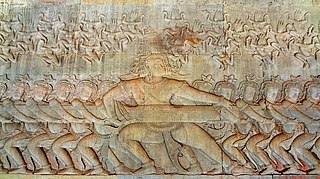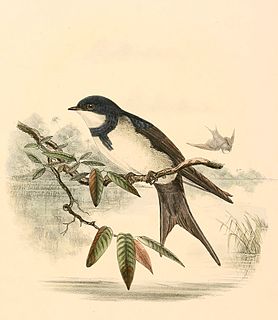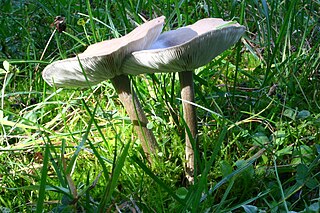
Asuras are a class of beings in Indian religions. They are described as power-seeking clans related to the more benevolent Devas in Hinduism. In its Buddhist context, the word is sometimes translated "titan, "demigod", or "antigod".
Hindu deities are the gods and goddesses in Hinduism. The terms and epithets for deity within the diverse traditions of Hinduism vary, and include Deva, Devi, Ishvara, Ishvari, Bhagavān and Bhagavati.

The greater yellowlegs is a large North American shorebird. The genus name Tringa is the New Latin name given to the green sandpiper by Aldrovandus in 1599 based on Ancient Greek trungas, a thrush-sized, white-rumped, tail-bobbing wading bird mentioned by Aristotle. The specific melanoleuca is from Ancient Greek melas, "black", and leukos, "white".

Ailuropoda is the only extant genus in the ursid (bear) subfamily Ailuropodinae. It contains one living and three fossil species of panda.

Deva means "heavenly, divine, anything of excellence", and is also one of the terms for a deity in Hinduism. Deva is a masculine term; the feminine equivalent is Devi.

Naja is a genus of venomous elapid snakes known as cobras. Members of the genus Naja are the most widespread and the most widely recognized as "true" cobras. Various species occur in regions throughout Africa, Southwest Asia, South Asia, and Southeast Asia. Several other elapid species are also called "cobras", such as the king cobra and the rinkhals, but neither are true cobras. They are not true cobras in that they do not belong to the genus Naja, but instead each belong to monotypic genera Hemachatus and Ophiophagus.

An asura in Buddhism is a demigod or titan of the Kāmadhātu. They are described as having three heads with three faces each and either four or six arms.

The black-collared swallow is a species of bird in the family Hirundinidae. It is found in Argentina, Bolivia, Brazil, Colombia, French Guiana, Guyana, Paraguay, Suriname, and Venezuela. Its natural habitat is rivers.

Asura is a genus of moths in the subfamily Arctiinae erected by Francis Walker in 1854.

Melanoleuca is a poorly known genus of saprotrophic mushrooms traditionally classified in the family Tricholomataceae. Most are small to medium sized, white, brown, ocher or gray with a cylindrical to subcylindrical stipe and white to pale yellowish gills. The basidiospores are ellipsoid and ornamented with amyloid warts. Melanoleuca is considered a difficult group to study due to their macroscopic similarities among species and the need of a thorough microscopic analysis to separate species. DNA studies have determined that this genus is closely related to Amanita and Pluteus and that it does not belong to the family Tricholomataceae.

The forest cobra, also commonly called the black cobra and the black and white-lipped cobra, is a species of venomous snake in the family Elapidae. The species is native to Africa, mostly the central and western parts of the continent. It is the largest true cobra species with a record length of 3.2 metres. Although it prefers lowland forest and moist savanna habitats, this cobra is highly adaptable and can be found in drier climates within its geographical range. It is a very capable swimmer and is often considered to be semi-aquatic. The forest cobra is a generalist in its feeding habits, having a highly varied diet: anything from large insects to small mammals and other reptiles. This species is alert, nervous and is considered to be a very dangerous snake. When cornered or molested, it will assume the typical cobra warning posture by raising its fore body off the ground, spreading a narrow hood, and hissing loudly. Bites to humans are less common than from other African cobras due to various factors, though a bite from this species is a life-threatening emergency.

Asura's Wrath is an action video game developed by CyberConnect2 and published by Capcom. Asura's Wrath was first announced at the Tokyo Game Show in 2010, and was released worldwide in February 2012. The game is playable on PlayStation 3, Xbox 360, Xbox One & Xbox Series X/S via 360 backwards compatibility, and the PlayStation 4 and PC via PlayStation Now.
Melanoleuca privernensis is a species of fungus in the Pluteaceae family. It was originally named Kinia privernensis in 2008 and a new genus Kinia was erected to contain it. Two years later, molecular analysis showed that it was closely related to Melanoleuca, and Kinia was reduced to a subgenus of Melanoleuca.

Melanoleuca melaleuca is a species of mushroom in the family Tricholomataceae, and it is the type species of its genus Melanoleuca. It is difficult to distinguish from other related species firstly because it is variable, secondly because the taxonomic criteria are often based on characteristics which have later been found to be variable, and thirdly because there is much disagreement between authorities as to exactly how the species should be defined.
Milgithea melanoleuca is a species of snout moth in the genus Milgithea. It was described by George Hampson in 1896. It is found in Colombia.
Asura strigipennis is a moth of the family Erebidae. It was described by Gottlieb August Wilhelm Herrich-Schäffer in 1914. It is found on Java, Sumatra and in China, Taiwan and India.
Asura quadrilineata is a moth of the family Erebidae. It is found on Aru and in Australia.

Cyme sexualis is a moth of the subfamily Arctiinae first described by Felder in 1864. It is found on Ambon, Sulawesi, the Dampier Archipelago. and in New Guinea.
Morpheis melanoleuca is a moth in the family Cossidae. It was described by Hermann Burmeister in 1878. It is found in Argentina.
Epiricania melanoleuca is a moth in the family Epipyropidae. It was described by Thomas Bainbrigge Fletcher in 1939. It is found in India, where its larvae are external parasitoids of the sugarcane planthopper. It has been used in biological pest control against this pest.












